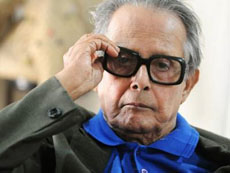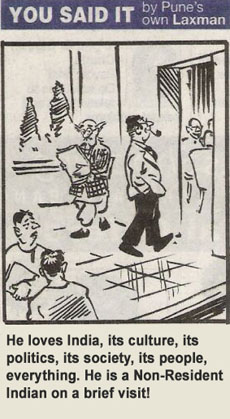It requires a truly great cartoonist to transcend the worlds of art and journalism and reach out to the “everyday” world — R.K. Laxman was one of the few cartoonists who did this on a daily basis until he passed away a few days ago on Monday, January 26 at Pune, India.

Mr. Laxman’s “Common Man” was the central character in the “You Said It” comic strip — his cartoons enjoyed unusual prominence in a major newspaper (The Times of India) by appearing daily on the paper’s front page. Mr. Laxman was born in 1921. Beginning “You Said It” in 1951, R.K. Laxman cartoons educated and amused readers with looks more than words. In his autobiography, he said, “I do not remember wanting to do anything else except draw.”
With this article, Artwork Abode remembers the life and work of R.K. Laxman while also reminiscing about how his cartoons impacted art lovers, cartoonists and common people everywhere.
A Budding Cartoonist
Like many artists, R.K. (Rasipuram Krishnaswamy) Laxman started drawing wherever he could at an early age — on the walls, doors and floors of his family’s house at first. Fortunately for all of us, his early educators encouraged his art even though he chose to use teachers as convenient and ripe material for caricatures. This was undoubtedly the beginning of R.K. Laxman’s proclivity for edgy satire and political cartoons.
Born in the state of Mysore, R.K. Laxman also encountered rejections that all too many artists are familiar with during creative careers. For example, an art school dean in Mumbai rejected his application, commenting that the submitted work “lacked the kind of talent required to qualify for enrollment in our institution as a student.”
Inspired by Sir David Low
A prominent early influence for Mr. Laxman’s budding career was Sir David Low, a British political cartoonist. R.K. Laxman also reported being fascinated by magazine illustrations — “Bystander,” “Strand” and “Punch” were prime examples.
Like all effective satirists, R.K. Laxman regularly paid tribute to his subjects — “Alarmingly, the politicians walk, talk and behave as though they were modeling perpetually for the cartoonist!” As he noted, while politicians might have been bad for the people, the same politicians were helpful for his profession. Mr. Laxman also observed, “I am grateful to my leaders for keeping my profession flourishing.”
His professional work included an autobiography, essays and short stories in addition to a diverse collection of artwork — but his favorite target was always political hypocrisy.
Igniting Cartoons and Rise to Fame

While “You Said It” originally included background characters, the realities of meeting a daily deadline caused Mr. Laxman to focus on his true passion — the Common Man. With Gandhi glasses, dhoti, checkered jacket and hair that seemingly defied gravity, the Common Man achieved cult status in India. At least two statues and one commemorative postal stamp were created as lasting tributes to the Common Man. More importantly, R.K. Laxman’s Common Man was enjoyed for over 50 years by millions of fans.
A Nation’s Uncrowned Conscience Keeper
Reflecting the conscience of a nation is not an easy task. For R.K. Laxman and the Common Man series, this meant total daily isolation for six hours each day. The search for new ideas was always a challenge — as he said, “You have to come up with new and innovative ideas each day.” Imagine doing that for over five decades!
Everyone on the Artwork Abode team joins in paying tribute to R.K. Laxman — We will all miss him!
Please share this article on social media with your friends and leave your comments about R.K. Laxman and political cartoonists below.
– ArtworkAbode



